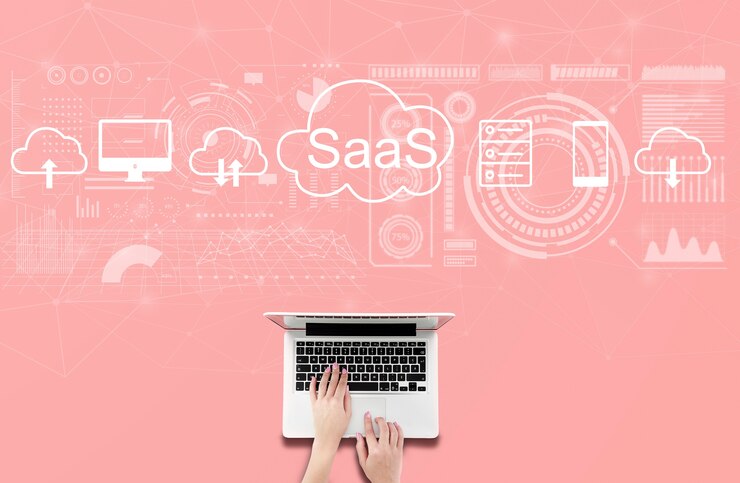What is SaaS And How Does It Work?
SaaS – software as a service concept with person using a laptop on a white table
SaaS is a cloud-based service delivery model that transformed the way business processes are carried out today. SaaS applications are cloud-hosted and web-based so that they eliminate the software installation requirements on-premises. It has many advantages for the company as follows: lower costs, better scalability, and automatic upgrades.
With SaaS, one of the most important advantages is that companies do not have to install and operate applications on their computers or in data centers by themselves. This removes the cost of hardware procurement, provisioning, and maintenance as well as licensing software installation and support. On the contrary, companies can simply sign up for a SaaS product that gives them access to software over the Internet.
SaaS solutions are also extremely scalable and can be scaled either up or down, depending on business requirements. This enables businesses to change their software usage according to their needs and without any concern about hardware limitations or software problems.
Benefits of SaaS
SaaS, Software as a Service. Internet and networking Technology concept.
SaaS solutions help to lower the cost and increase the accessibility of products and services, especially for small-medium enterprises. The proper SaaS can help to automate repeatable business processes through applications based on the SaaS. With efficiencies, a company gets less time either to do its tasks or produce more widgets that help the SaaS solutions provide them with an expanded hiring pool of qualified candidates. The implementation of a SaaS solution fosters collaboration among invested parties.
SaaS offers several benefits to businesses, including:
- Reduced Time to Benefit: Businesses can quickly adopt SaaS apps because they are easy to install and do not need any hassle.
- Lower Costs: SaaS can reduce both software and hardware costs because it negates the need for on-site implementation of software.
- Scalability and Integration: SaaS apps can easily be integrated with other applications to improve workflows and are either developed or reduced based on the needs of an organization.
- High Compatibility: SaaS apps are more compatible as they were manufactured to work on various platforms and equipment.
- Automatic Updates: SaaS apps are patched by the provider, enabling companies to have access to new features and security updates at all times.
SaaS Implementation
SaaS implementation involves the incorporation of a software application into an already established system. It is a complicated procedure and must be preceded by the evaluation of an enterprise’s needs, budget, benefits, limits, and so on. Once the company is in a position to implement SaaS for its software adoption, it then begins implementation. The SaaS implementation stage is also known as the onboarding of SaaS.
Implementing SaaS applications requires careful planning and execution. Here are some best practices for SaaS implementation:
- Assign Ownership: Appoint a project manager to manage the integration process and consider all interested parties.
- Establish a Goal-Based Rollout Plan: Create a comprehensive implementation strategy with goals and corresponding steps to fulfill these purposes.
- Accept the Change: Train employees on the merits of implementing this new system and convince them to shift.
- Promote and Track Adoption: Observe the rate of adoption and assist those employees who require assistance.
- Determine the Impact on Business Processes: Identify the potential effect that a newly proposed system can have on your business process methodology and make changes if needed.
- Assess and Improve Business Impact: Monitor the effect of the new system on business operations and make changes where appropriate.
SaaS Security
The main thing you should know in terms of SaaS management is the perfect security for a platform, such as eliminating unused licenses and shadow IT. SaaS security entails the protection measures and protocols concerned with safeguarding confidential information, e.g., customer details (personal data), which are kept in the cloud. Some of SaaS security best practices are.
- Employ Products with Robust Authentication: It is important to know about the different authentication options provided by cloud service providers. Though some vendors provide MFA for enhanced security, others integrate with customer-managed identity providers.
- Monitor Data Sharing: Monitor SaaS program use regularly and watch for any suspicious or unusual activity. This helps to maintain an accurate record of service provision and the users of services throughout your organization.
- Vet the Provider: Make sure they comply with the data privacy and security requirements, cyber protection, and segregation of information within the SaaS provider’s audits. Rate potential SaaS suppliers regularly to find out how the service is used and kept.
- Maintain an Accurate Usage Inventory: All over your business, monitor the used services and by whom. This helps to identify potential security threats and ensures compliance with data protection laws.
- High Compatibility: One of the major features that make SaaS applications highly compatible is their ability to run on different platforms and devices.
- Automatic Updates: Automatic updates from the provider ensure that companies always have current security patches and features through SaaS applications.
SaaS Trends
SaaS is one of the fastest-growing industries, and if companies want to remain competitive in it they have no choice but to follow changes faster than ever. The SaaS trends to be watched for include AI, IoT, blockchain, and serverless computing as well as low-code developments. SaaS apps are increasingly incorporating artificial intelligence features that automate tasks and provide intelligent guidance.
SaaS apps allow insightful analysis of vast quantities of data generated by IoT devices. Transparent and secure data sharing occurs in SaaS applications with the help of blockchain technology. Serverless computing is a new paradigm that allows companies to deploy applications without being concerned about managing servers. Low-code development platforms are being used to develop SaaS applications quickly and efficiently.
In conclusion
SaaS offers various benefits to companies including cost reduction, greater flexibility, and automatic updates. This requires careful planning and execution, as SaaS applications need to comply with the best security practices. Finally, businesses have to be aware of the latest innovation developments in the SaaS sector which is moving very fast.






